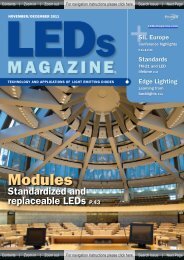Zoom In - Beriled
Zoom In - Beriled
Zoom In - Beriled
- No tags were found...
You also want an ePaper? Increase the reach of your titles
YUMPU automatically turns print PDFs into web optimized ePapers that Google loves.
Previous Page | Contents | <strong>Zoom</strong> in | <strong>Zoom</strong> out | Front Cover | Search Issue | Next PageABE FMaGSstandards | PROGRESS REVIEW______________of the existing standards for lamps or luminaires are directly applicableto SSL products. What this means is a method of measurementnot commonly used — absolute photometry.Under a relative measurement, the most common form of lightoutput determination, the luminaire under test and the lamp(s) aremeasured separately. Then the luminous intensity distribution dataare normalized by the total luminous flux of lamps used in the testedluminaire. Under the absolute method, the luminous intensity distributionof a luminaire is measured without separate measurementof the lamps.Section 9.3 of LM-79 details the measurement and the Annex goesinto the reasoning behind the requirement for absolute photometry.LM-79 recommends using an integrating sphere with a spectroradiometer,but other alternatives are provided including a sphere witha photometer and the use of a goniophotometer for measurements.The spectroradiometer returns the full spectral power distributionfrom which several characteristics are calculated, including chromaticity,CCT and CRI. For the goniophotometer, the result may bespatially non-uniform, but must be spatially averaged, weighted tointensity, over the angular range of measurement.Another key difference in photometry measurements for SSLdevices is thermal stabilization, which is determined by repeatedsequences of measurements until the difference over two measurementsis below a specified amount. <strong>In</strong> LM-79, the unit is stabilizedwhen three readings of light output and electrical power over 30 minutes,taken 15 minutes apart, fall within a 0.5% variation.The combination of the thermal stabilization, absolute photometryand other elements in LM-79 have made for a reliable test methodfor LED light sources.LM-80: Lumen maintenanceLumen maintenance is the gradual fading of the light output from anLED device over time. Many LED product specifications use lumenmaintenance to indicate product lifetime, but this is only one aspectof lifetime and not a complete measure of life. It does not, for example,provide a true measure of reliability. Lumen maintenance does, however,provide an indication of the fading of LED package light outputover time. When properly controlled and thermally managed, manyhigh-brightness LEDs can last many tens of thousands of hours, butwe need a consistent method to provide that information. Hence theneed for LM-80.The causes of this fading are only partially understood, but the primarycause relates directly to heat generated at the junction withinthe LED. It includes materials clouding, which is affected by packageand system design. A number of LED manufacturers, for example,have switched encapsulant material to silicone from epoxy, whichwas prone to yellowing from the light energy.The measurement of lumen maintenance is relatively straightforwardin concept — run the LEDs over a long period of time andmeasure the change in light output. Since it is impractical to measurethese devices for a decade, because they will be surpassed bynew generations of LEDs, some form of prediction or extrapolationis necessary.LM-80 was created for one important reason — to ensure consistency30 APRIL 2009 LEDsmagazine.comPrevious Page | Contents | <strong>Zoom</strong> in | <strong>Zoom</strong> out | Front Cover | Search Issue | Next PageABE FMaGS

















